February
- Rosa
- Feb 29, 2020
- 5 min read
Updated: Mar 31, 2020

Starting from Seed
With the frost date on the horizon, we've begun starting our seeds. In January, we spent many hours preparing a minutely-detailed calendar, plotting out the dates of sowing and planting for every flower and vegetable. Now, we have a seedling task nearly every day.
Most of our seeds are planted in soil blocks made out of starting mix. The littlest seeds must be placed onto the center of the cubes with a wet toothpick, since fingers would pick up a hundred at once. Larger seeds (or plants that grow very slowly) are started in cell packs and trays.
Every seed has its own germination needs: light, dark, heat, cool, a few days, a few weeks. But once they are up, they all go under the grow lights. As they reach up towards their artificial suns, they form "true leaves". Unlike the first leaves (known as cotyledons), these bear the shape of adult leaves. When they appear, we know its time to thin extra seedlings and fertilize the hungry little plants.
From there, the plants quickly grow stronger and taller. When they are ready, we carry them to their assigned garden bed and bury their roots in the bed. Seed starting can be tedious, but there are few greater joys than watching tiny green things unfold from cubes of earth and transform into hearty crops.
Arrival of the Eggs
The chickens have fully recovered from their (untimely) winter molting and returned full-time to laying eggs. With the Rhode Island Reds at last mature, Concetta is collecting more eggs than ever before. Each breed has its own egg color and shape; white, tan, brown, even speckled. Some chickens are more reliable than others, and the Reds are turning out to be some of the best.
Our SCDA Wholesale Egg Distributor licence arrived, and in celebration I followed along as Concetta prepared the eggs for delivery.
Concetta collects eggs twice a day and places them right into the refrigerator. Eggshells are protected by a membrane which excludes germs, so a fresh egg can actually be safely left at room temperature for several weeks. But once the egg is washed, the membrane is disturbed and the egg needs to be refrigerated. (Don't try leaving out a carton of store-bought eggs -- they've all been washed.)
Concetta cleans the eggs at a sanitized work station. First, she has to "candle" the eggs (though she uses a flashlight.) Illuminating the egg from one end, she checks for spots or internal imperfections. This allows her to quality-control for Grade-A eggs. Concetta then gently washes the eggs with a diluted bleach solution. As soon as she's finished, she packs them into cartons and then directly into a freezer bag for immediate delivery.
Turning the Compost
February has been an incessantly rainy month, which means the compost has been soaked through for weeks. Too much water deprives the microorganisms of oxygen and therefore stalls decomposition. In order to dry the pile and provide air flow, Lilly moved the compost to a new bay.
She used a pitchfork to load up the wheelbarrow. Each scoop excavated a little more of the pile, revealing various stages of decomposition. The top was only slightly decayed, while the bottom was unrecognizable as the grass, leaves, and food scraps it once was. We found worms, roly-polies, and other detritivores, as well as the white webbing of fungi. Still, the compost pile has a while to go before it is soil, and aeration will help it along.
Filling the Garden
Early in the month, we finished adding compost and mulch to the last of the of the field garden beds. The field garden was our primary vegetable garden from last year, but we built an entirely new vegetable garden this winter. Now the field garden houses perennials like lavender, artichokes, and strawberries, as well as our garlic crop. Since the winter was mild, the garlic tops never died back, and fill out much of the field garden with their stout green leaves. When it's warmer, we'll add corn and sweet potatoes.
In the new vegetable garden, we planted our first spring crops. First, we raked the leaf mulch off of the beds and into the paths. In the windy spring, the leaves might blow over and smother young plants if left on the beds. Also, just like insulation, the leaf mulch keeps the soil cold on sunny days. Since warmth can help plants grow faster, we'll leave the mulch in the path until the plants are older.
We planted an entire bed with plugs of mixed baby-leaf lettuce. Two other beds were filled with Pak Choy (white-stemmed Bak Choy). Fingers crossed, in a month or two they will be ready to harvest.
Priming Peas
We also sowed sugar snap peas. Peas are legumes, which means they are members of the Fabaceae family. This family has a remarkable partnership with nitrogen-fixing bacteria. Plants can only use nitrogen in specific forms, and cannot transform atmospheric nitrogen into those useful forms. Bacteria can. So, in exchange for sugar and housing inside special nodes on the plant roots, the bacteria provide legumes with nitrogen.
In order to give young pea plants a strong start on that partnership (and thus on their growth), we inoculated the seeds with the bacteria. The inoculate looks like a black powder, which we applied to dampened seeds. Then into the ground they went, coated with their future business partners.
Tiny Turnips
We also sowed turnips into the cold February soil. Turnip seeds are much smaller than peas. We marked three (sorta) straight rows and every 3 inches dropped a few tiny future-turnips. When they are sprouts, the extra plants will be thinned out. We covered them with a thin blanket of soil. Then, like all seeds and transplants, they were immediately watered.
During the frost-prone months, we cover all of our young plants with row covers. The covers act like tiny greenhouses, raising the temperature a few degrees, and also protect from the wind always roaring across our hill top. But row covers also protect plants from being eaten. This is especially important for greens like Pak Choy, kale, and collards, which are members of the Brassica family. This family is infamously prone to pests. Larger herbivores, like rabbits and deer, are also excluded by covers. We've seen deer at the edges of our woods in the misty mornings, though so far they haven't ventured into the garden.
Signs of Spring
Though the air remains cold and the sky gray, the plants and animals are warming up. In the greening grass, daisies and henbit bloom. Blueberries break open pink buds. Stock unfurls stalks of white and purple petals. The bees hover in the moments of sun, knowing soon the warmth will come to stay.














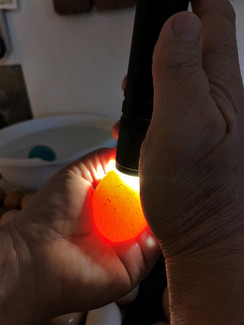





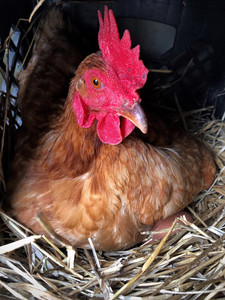











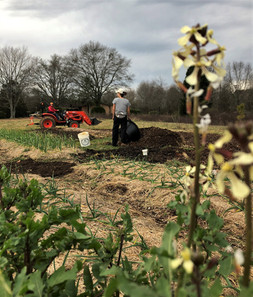

















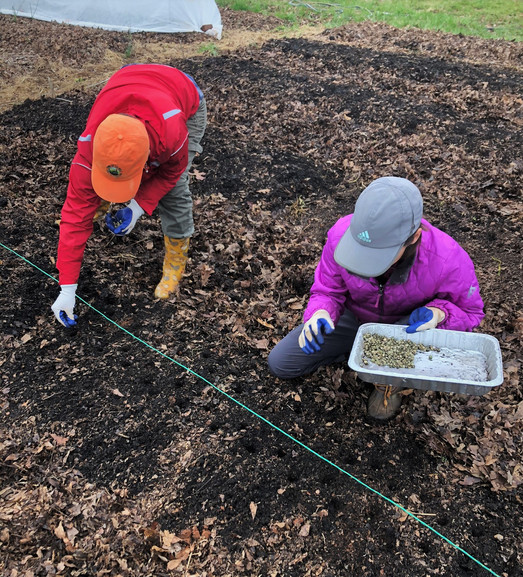

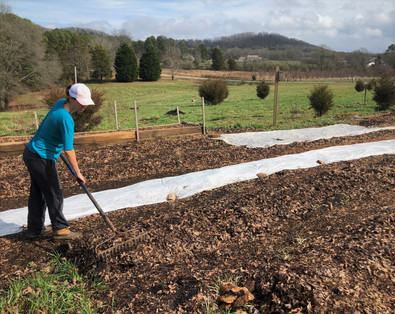





















Comments